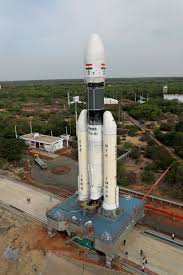chandrayaan -2
Chandrayaan 2 is an Indian lunar mission that will boldly go where no country has ever gone before — the Moon’s south polar region. Through this effort, the aim is to improve our understanding of the Moon — discoveries that will benefit India and humanity as a whole. These insights and experiences aim at a paradigm shift in how lunar expeditions are approached for years to come — propelling further voyages into the farthest frontiers.

Why are we going to the Moon?
The Moon is the closest cosmic body at which space discovery can be attempted and documented. It is also a promising test bed to demonstrate technologies required for deep-space missions. Chandrayaan 2 attempts to foster a new age of discovery, increase our understanding of space, stimulate the advancement of technology, promote global alliances, and inspire a future generation of explorers and scientists.
What are the scientific objectives of Chandrayaan 2? Why explore the Lunar South Pole?
Moon provides the best linkage to Earth’s early history. It offers an undisturbed historical record of the inner Solar system environment. Though there are a few mature models, the origin of Moon still needs further explanations. Extensive mapping of lunar surface to study variations in lunar surface composition is essential to trace back the origin and evolution of the Moon. Evidence for water molecules discovered by Chandrayaan-1, requires further studies on the extent of water molecule distribution on the surface, below the surface and in the tenuous lunar exosphere to address the origin of water on Moon.
The lunar South Pole is especially interesting because of the lunar surface area here that remains in shadow is much larger than that at the North Pole. There is a possibility of the presence of water in permanently shadowed areas around it. In addition, South Pole region has craters that are cold traps and contain a fossil record of the early Solar System.
Chandrayaan-2 will attempt to soft land the lander -Vikram and rover- Pragyan in a high plain between two craters, Manzinus C and Simpelius N, at a latitude of about 70° south.
Geosynchronous Satellite Launch Vehicle Mark-III (GSLV Mk-III)
The GSLV Mk-III will carry Chandrayaan 2 to its designated orbit. This three-stage vehicle is India’s most powerful launcher to date, and is capable of launching 4-ton class of satellites to the Geosynchronous Transfer Orbit (GTO).
Its components are:
S200 solid rocket boosters
L110 liquid stage
C25 upper stage
A legacy of Chandrayaan 1
15th August, 2003: Chandrayaan programme is announced by Prime Minister Atal Bihari Vajpayee
22nd October, 2008: Chandrayaan 1 takes off from the Satish Dhawan Space Centre at Sriharikota
8th November, 2008: Chandrayaan 1 enters a Lunar Transfer Trajectory
14th November, 2008: The Moon Impact Probe ejects from Chandrayaan 1 and crashes near the lunar South Pole — confirms presence of water molecules on Moon’s surface
28th August, 2009: End of Chandrayaan 1 programme
